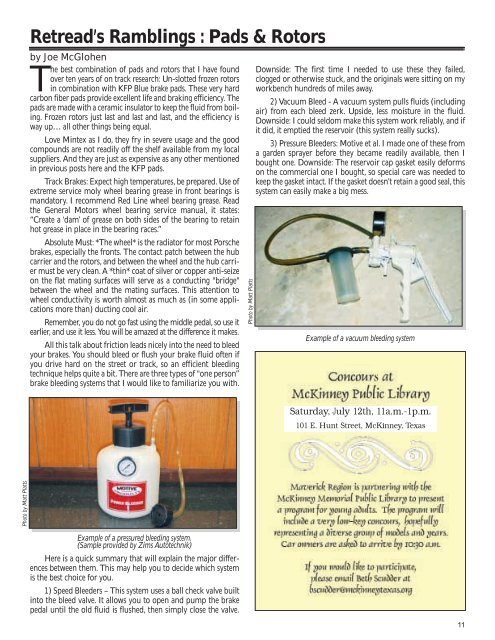Slipstream - June 2003
The monthly newsletter of the Maverick Region of the Porsche Club of America
The monthly newsletter of the Maverick Region of the Porsche Club of America
You also want an ePaper? Increase the reach of your titles
YUMPU automatically turns print PDFs into web optimized ePapers that Google loves.
Retread’s Ramblings : Pads & Rotors<br />
by Joe McGlohen<br />
The best combination of pads and rotors that I have found<br />
over ten years of on track research: Un-slotted frozen rotors<br />
in combination with KFP Blue brake pads. These very hard<br />
carbon fiber pads provide excellent life and braking efficiency. The<br />
pads are made with a ceramic insulator to keep the fluid from boiling.<br />
Frozen rotors just last and last and last, and the efficiency is<br />
way up… all other things being equal.<br />
Love Mintex as I do, they fry in severe usage and the good<br />
compounds are not readily off the shelf available from my local<br />
suppliers. And they are just as expensive as any other mentioned<br />
in previous posts here and the KFP pads.<br />
Track Brakes: Expect high temperatures, be prepared. Use of<br />
extreme service moly wheel bearing grease in front bearings is<br />
mandatory. I recommend Red Line wheel bearing grease. Read<br />
the General Motors wheel bearing service manual, it states:<br />
“Create a ‘dam’ of grease on both sides of the bearing to retain<br />
hot grease in place in the bearing races.”<br />
Absolute Must: *The wheel* is the radiator for most Porsche<br />
brakes, especially the fronts. The contact patch between the hub<br />
carrier and the rotors, and between the wheel and the hub carrier<br />
must be very clean. A *thin* coat of silver or copper anti-seize<br />
on the flat mating surfaces will serve as a conducting "bridge"<br />
between the wheel and the mating surfaces. This attention to<br />
wheel conductivity is worth almost as much as (in some applications<br />
more than) ducting cool air.<br />
Remember, you do not go fast using the middle pedal, so use it<br />
earlier, and use it less. You will be amazed at the difference it makes.<br />
All this talk about friction leads nicely into the need to bleed<br />
your brakes. You should bleed or flush your brake fluid often if<br />
you drive hard on the street or track, so an efficient bleeding<br />
technique helps quite a bit. There are three types of "one person”<br />
brake bleeding systems that I would like to familiarize you with.<br />
Photo by Matt Platts<br />
Downside: The first time I needed to use these they failed,<br />
clogged or otherwise stuck, and the originals were sitting on my<br />
workbench hundreds of miles away.<br />
2) Vacuum Bleed - A vacuum system pulls fluids (including<br />
air) from each bleed zerk. Upside, less moisture in the fluid.<br />
Downside: I could seldom make this system work reliably, and if<br />
it did, it emptied the reservoir (this system really sucks).<br />
3) Pressure Bleeders: Motive et al. I made one of these from<br />
a garden sprayer before they became readily available, then I<br />
bought one. Downside: The reservoir cap gasket easily deforms<br />
on the commercial one I bought, so special care was needed to<br />
keep the gasket intact. If the gasket doesn’t retain a good seal, this<br />
system can easily make a big mess.<br />
Example of a vacuum bleeding system<br />
Saturday, July 12th, 11a.m.-1p.m.<br />
101 E. Hunt Street, McKinney, Texas<br />
Photo by Matt Platts<br />
Example of a pressured bleeding system.<br />
(Sample provided by Zims Autotechnik)<br />
Here is a quick summary that will explain the major differences<br />
between them. This may help you to decide which system<br />
is the best choice for you.<br />
1) Speed Bleeders – This system uses a ball check valve built<br />
into the bleed valve. It allows you to open and pump the brake<br />
pedal until the old fluid is flushed, then simply close the valve.<br />
11


















